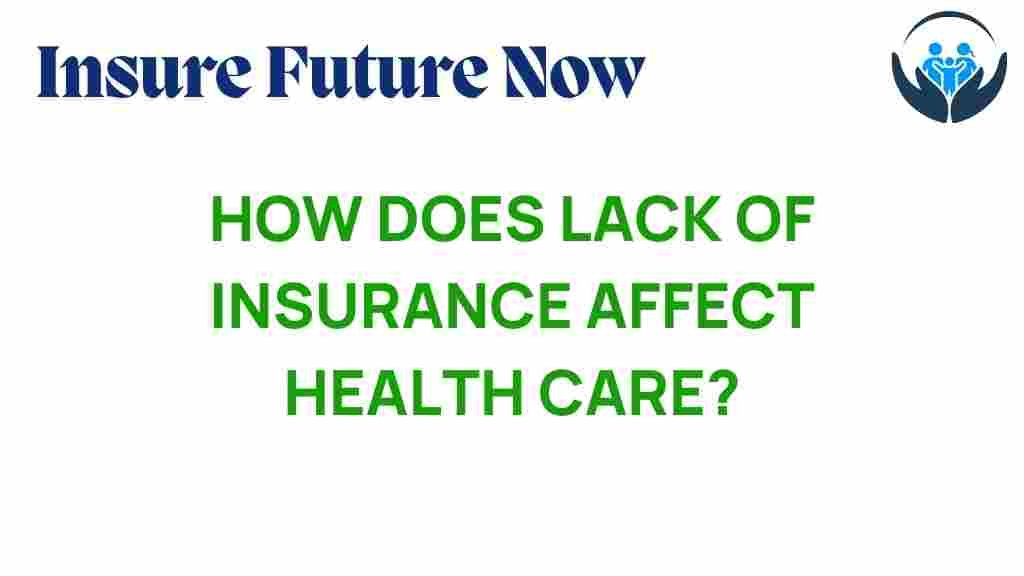The Hidden Costs: How Lack of Insurance Impacts Health Care Access
Access to health care is a fundamental aspect of maintaining public health, yet millions of individuals face barriers due to a lack of insurance. The implications of inadequate coverage extend beyond individual health, affecting entire communities and the broader healthcare system. This article explores the hidden costs associated with a lack of insurance, examining its impact on health care access, affordability, and equity.
Understanding the Landscape of Health Care and Insurance
Health care in the United States is a complex system influenced by various factors, including insurance coverage, government policies, and socioeconomic status. The relationship between insurance and health care access is critical, as insurance often determines the affordability and availability of medical services.
- Insurance Coverage: Provides financial protection against high medical costs.
- Health Care Access: Refers to the ability to obtain necessary medical services.
- Affordability: The cost of health care services and whether individuals can pay for them.
- Equity: Ensuring that all individuals, regardless of background, have equal access to health care.
The Costs of Being Uninsured
Being uninsured leads to several hidden costs that can strain individuals and communities. These costs manifest in various ways:
1. Increased Out-of-Pocket Expenses
Without insurance, individuals are often faced with the full brunt of medical costs:
- Higher prices for services: Uninsured patients typically pay more than insured patients for the same services.
- Lack of preventive care: Individuals without coverage often forgo routine check-ups, leading to more severe health issues that are costlier to treat.
- Emergency care costs: Many uninsured individuals rely on emergency rooms for care, resulting in exorbitant bills that can lead to financial distress.
2. Delayed Treatment and Poor Health Outcomes
Access to timely health care significantly influences health outcomes. The lack of insurance often results in:
- Delayed diagnoses: Uninsured individuals may wait until conditions worsen before seeking care.
- Increased morbidity and mortality: A lack of timely treatment can lead to preventable complications or even death.
- Chronic disease management issues: Patients with chronic conditions are less likely to receive regular care, leading to worsening health.
3. Economic Burden on Communities
The implications of uninsured individuals extend to the community level, affecting public health and local economies:
- Higher healthcare costs for everyone: Hospitals often pass on the costs of uncompensated care to insured patients, increasing premiums.
- Reduced productivity: Uninsured individuals may miss work due to untreated health issues, impacting local business productivity.
- Increased reliance on public assistance programs: Communities may face higher demands for social services as uninsured individuals seek help.
Impacts on Underserved Populations
Underserved populations, including low-income individuals and racial minorities, are disproportionately affected by the lack of insurance:
- Health Disparities: Uninsured individuals in these groups often experience worse health outcomes.
- Access to Quality Care: They may reside in areas with fewer healthcare providers, exacerbating their lack of access.
- Social Determinants of Health: Factors such as education, income, and environment play a significant role in health care access.
Steps to Improve Health Care Access for the Uninsured
Addressing the hidden costs of being uninsured requires a multifaceted approach:
1. Policy Changes
Government policies play a crucial role in expanding health care access:
- Expand Medicaid: States that have expanded Medicaid have seen increased coverage among low-income populations.
- Subsidize insurance premiums: Providing financial assistance can help individuals afford coverage.
- Encourage community health programs: Investing in local health initiatives can improve access and health outcomes.
2. Increase Awareness and Education
Many individuals are unaware of their insurance options:
- Outreach programs: Informing communities about available resources can help increase enrollment in health insurance.
- Educational workshops: Teaching individuals about the importance of preventive care can encourage them to seek coverage.
3. Leverage Technology
Technology can help bridge the gap for uninsured individuals:
- Telehealth services: Providing remote care options can improve access for those unable to visit healthcare facilities.
- Health apps: Tools that help individuals manage their health can promote preventive care and treatment adherence.
Troubleshooting Common Issues in Health Care Access
Despite the best efforts, there can still be hurdles in accessing health care:
Identifying Barriers
To troubleshoot issues related to health care access, consider the following:
- Assess financial readiness: Determine if costs are a barrier to seeking care.
- Evaluate location: Identify if there are sufficient healthcare providers in the area.
- Understand coverage options: Research available insurance plans to find the best fit.
Finding Solutions
Once barriers are identified, take proactive steps:
- Seek community resources: Local health departments may offer sliding scale services or free clinics.
- Utilize online resources: Websites like HealthCare.gov can help individuals navigate their insurance options.
- Engage with local advocacy groups: Organizations focused on health equity can provide support and resources.
Conclusion
The hidden costs of lacking insurance are profound and far-reaching, impacting not only the individuals without coverage but also the health of entire communities. By understanding the implications of uninsurance on health care access, affordability, and equity, we can work towards solutions that foster a healthier society for all. It is crucial for policymakers, health care providers, and communities to collaborate in addressing these challenges, ensuring that every individual has the opportunity to receive quality health care.
For more information on improving health care access, check out our resources here.
This article is in the category Coverage and created by InsureFutureNow Team
